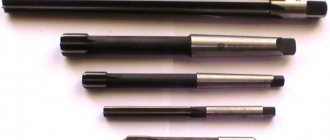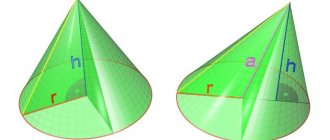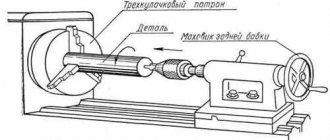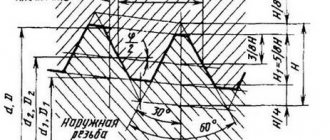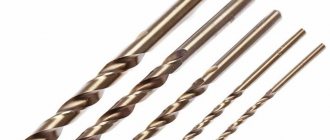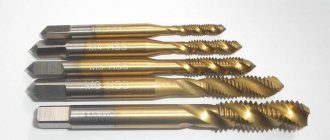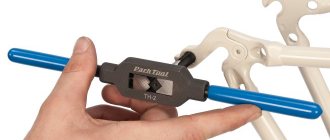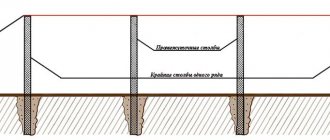A reamer is a multi-blade tool for a drilling or lathe, designed for final finishing of a hole (countersinking) to the required size, accuracy and roughness. Also used for pre-machining cylindrical holes. Typical reamer sizes make it possible to process surfaces up to 6-11 accuracy grades and up to 6.3-10 microns of roughness (Rz). The main elements of the tool are the working part and the body; the thickness of the removed layer ranges from hundredths to 1 mm.
Manual conical reamer and other types of devices
In order to obtain holes with a clean surface, or if a precise fit of the hole is required for some kind of ground part, a process called reaming is performed. It can be done manually or you can use a drilling machine on which reamers are installed. In the first case, during work, a manual conical reamer is rotated with a crank.
These tools are cylindrical, conical and stepped (according to the type of hole they process). In terms of accuracy, they are divided into the following: those indicating quality (for cylindrical reamers), those indicating quality (roughing, finishing and intermediate between them - for conical types). This also includes cylindrical reamers with a calibrated allowance, which are necessary in order to further grind the tool to the desired size. And the last type in this group is adjustable reamers.
According to the way they are clamped, they are divided into:
- manual (they have a square tail for a knob),
- machine (with a cylindrical or conical shank),
- attachments for machines (installed on a special mandrel, as a rule, needed for large tools).
The working part of this device has cut teeth, usually from 6 to 14, along which there are grooves that form cutting edges.
The part that is located at the bottom of the reamer is designed to remove chips, and the part at the top, called the calibrating part, can launch the tool in the desired direction to completely calibrate the holes. In general, a tool is needed in order to ream tapered holes. The allowance allowed during the roughing stage of work is no more than a fifth of one millimeter, and for the finishing stage it is taken equal to a tenth of a millimeter.
Tool selection factors
Effective use of a reamer depends on the correct selection of the type, size and other characteristics of the tool and the hole being machined (type, location, workpiece material, etc.). So, for manual countersinking, you need to manually select a tool with a square shank for the wrench. Floating countersinks and tools with straight flutes cannot be used to work with intermittent holes with slotted veneers. Processing of this type of holes is carried out with a countersink with screw grooves.
To ream holes of increased length, where the standard tool size is not enough, mounted countersinks on a long mandrel are used. The type of tool attachment affects the choice of length and design. It is also necessary to take into account the length of the hole and the type of metal-cutting equipment on which the processing is performed.
Economic factors also influence the choice of tool. For mass production of parts, it is advisable to use rigid countersinks or special types. At the same time, for small and medium-sized series, the best option would be to use universal designs - these are adjustable tools or countersinks with inserted working edges.
The tool material is selected, as a rule, taking into account the material of the workpiece being processed. To work with hard parts, countersinks with carbide plates are used.
Deployment - what mistakes should not be made?
To obtain the cleanest possible surface, as well as to cool the tool during operation, the holes that were made with a drill in the steel product are lubricated with mineral oil. If the working surface is copper, the hole is treated with emulsion, with aluminum - with turpentine, and if it is brass or bronze, the holes are left without lubrication, since they unfold in a dry state.
High quality of the machining process can be achieved if the reamer has quite a lot of edges cutting the metal. It is thanks to this tool that you can remove a small allowance. After all, by removing a small thickness of metal, you can achieve fairly high accuracy.
A common mistake is the wrong choice of tool for reaming: many people choose a countersink instead of a reamer for this purpose. This is a semi-finish tool that is not capable of showing greater accuracy, it has fewer cutting sharpenings, and in general it is intended for other purposes. Therefore, you need to be careful when choosing a tool. And within one type of tool, you should choose the type wisely.
Operating principle
The use of a reamer makes it possible to obtain internal surfaces with an accuracy grade of 6-9 and a roughness Ra of 0.32–1.25 microns. High-class characteristics are achieved due to the design of the tool with a large number of cutting edges, which can be from 4 to 14 pieces.
The quality of processing when performing a deployment operation is determined by a set of factors:
Surface roughness classes
- The size of the allowance removed during processing;
- Machine cutting conditions;
- Quality of workmanship and sharpening;
- Features of geometry and design;
- Type of material being processed.
The deployment process goes like this. A cutting tool of the required diameter is brought to the edge of the hole. Then it receives a cutting movement, which, with manual and mechanical feed, consists of rotation of the tool and feed along the axis of the hole.
The amount of allowance in tenths or hundredths of a millimeter is the difference between the diameter of the hole and the selected tool.
Cylindrical and conical holes are processed by reaming using hand and machine tools of the appropriate shape.
Reamer is a cutting tool that is needed for finishing holes
Conical reamer - tool features
One of the types of reamers described in this article, conical, is used when working in more difficult conditions than those when working with cylindrical types. This is due to the fact that the latter have small cutting edges, and the allowance they remove is insignificant. Conical reamers, on the other hand, use their entire length for cutting. In this regard, when working with them, the speed of work and the supply of metal are slower than if a cylindrical type of reamer was used.
The above-mentioned conical type tools are used to ream conical holes. To do this, the kit contains three elements: roughing, intermediate and finishing tools . They are manufactured for the installation of conical threads and Morse tapers. For high-quality production, steel grades YUA, U12A and others are used, as well as plates made of hard alloys. An interesting feature of conical reamers is the following. They have transverse slots on their teeth, located in a straight line, through which the removed chips are removed, while they are not located along the entire length of the tooth, which allows you to work with the tool with little effort.
Rough development is performed in steps. In this case, it usually takes the form of individual teeth that crush the chips into pieces.
This device can also be made in the shape of a pyramid with three, five or eight sides, with cutting ribs. Conical reamers can be helical, and with only one or a pair of teeth. The size of screw tools is up to 5 cm in diameter, they are widely used in the repair of steam locomotives. Such a tool today has found quite a wide range of applications in the field of construction and repair due to its durability, reliability, as well as the fact that such a reamer can process holes with a large allowance, and especially if they have keyway holes. The disadvantages include the fact that changing the scan, if necessary, can take a lot of time.
Ream size
A countersink is a universal tool that provides the ability to process holes within certain diameter limits due to the possibility of adjustment. The diameter range depends on the size of the tool itself. The larger the diameter, the higher the adjustment range. This is convenient in cases where it is not possible to select the exact size of the cone drill. The size of the countersink is indicated by a fractional number and is selected depending on the parameters of the workpiece hole and accuracy requirements.
Depending on the design of the tool, reamers are available in the following diameter range:
- cylindrical - from 3 to 50 mm.
- conical - from 6.39 to 40.9 minimum diameter, from 7.6 to 45.7 maximum.
- machine - from 34 to 50 mm external, from 13 to 22 mm internal.
Main types
Taking into account the thickness of the layer being removed, processing is carried out with one tool, or a set of rough and finishing reamer, and sometimes semi-finish. The tool for preliminary and finishing processing differs in the type of cutting blades and their number. There are teeth or projections along the tooth line of the rough and semi-finish reamers.
The standard provides for the classification of scan types according to the following criteria:
- Type of hole being machined – cylindrical and conical;
- Type of processing (roughing, finishing);
- Tool fixation method;
- Cutting edge design;
- Teeth arrangement;
- Adjustable for processing size;
- Material for production.
GOST 1672-80 sets out the standards for the manufacture of conical reamers that form precise conical holes. Existing models allow processing cones for the following purposes:
Development GOST 1672-80
- For subsequent cutting of tapered threads;
- For installation of conical pins;
- For installation of metric cone;
- Mating hole “Morse taper”;
- For a standard range of tapers 1:20, 1:30 and others.
The regulatory document regulates the geometry of conical reamers, roughness, permissible dimensional deviations and accuracy class of holes obtained after machining.
Metal-cutting tools for deployment are divided into 2 large groups: manual and machine. Machine reamers are used in drilling, turning and boring machines.
There are visible differences between the groups. Hand tools - with longer working edges and square. Machine ones - with a shortened working part and a long belt. They are mounted in holders that are mounted in the spindle.
Manual
Reamers are produced in accordance with GOST 7722-77 with a size range of 3-58 mm with a design step of 1 mm and 0.5 mm up to a diameter of 15.5 mm. A set with a wide range of diameters allows you to machine a wide variety of holes in parts.
Reaming with a hand tool is accomplished by using a crank to secure and impart the cutting motion. The connection to the knob is made through a square section on the edge of the shank and a groove of the appropriate size.
Manual sweep begins with the work area and approach. The entry part is made at an angle to the axis and has a smaller initial diameter at the edge. The shallow chamfer section makes it easier to position and cut into the stock.
Machine
For unfolding by machine tools, metal-cutting machines with a conical chuck in which the tail part is fixed are used. Taper shanks are normalized and the number of taper used is related to the diameter of the reamer. Such a cutting tool is made in one piece from high-speed steel.
Several reaming options are available. The design and geometry are determined by GOST 1672-80.
Machine scans are:
- With cylindrical and conical shank shape;
- Mounted type;
- With replaceable or adjustable knives;
- With soldered plates.
Machine scan
Adjustable
Adjustable reamers allow you to change the outer size of the cutting head to suit a specific hole diameter. This is especially necessary if the processing diameter is not a whole number, but a fractional one, for example, Ø15.3 mm or Ø 10.75 mm.
Adjustable rack reamer 10.0-10.5 mm
The small diameter tool allows you to adjust the processing size within 1 mm. For larger diameters, a wider setting of 1-3 mm is possible.
In such reamers, replaceable high-speed steel knives are installed, which are fixed by wedge inserts with linings. The dial head is secured with two nuts. After loosening the locknut, the knives are set to the processing diameter, measured using a caliper and micrometer, and secured again.
When the adjusting nut is tightened, the knives move upward, thereby increasing the diameter of the tool. By loosening the nut it is possible to reduce the size. For convenience, when setting up, the processing tool is held by the square.
Expanding reamers
Expanding reamers - description
Due to their design features, reamers are called expansion reamers. The principle of adjusting the expansion reamer is based on the movement of the ball and screw. When the screw rotates from the bottom side, the ball moves and pushes the edges apart. They diverge from the center and the outer size increases.
The control limit for such a tool is smaller. It is 0.15-0.5 mm and depends on the size of the scan. It is recommended to control the adjustment force to avoid damage to the housing.
In the production of reamers, tool and high-speed steel are used - 9ХС, Р6М5, Р18, Р6М5. In tool catalogs of foreign companies, the material is designated HSS.
